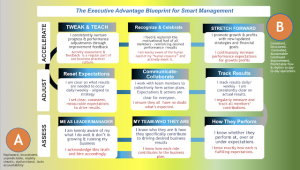 In every company where customer experience is a hallmark of their success, the CEO is the ringleader of customer-centered management. This type of leadership is indeed rare: it wasn’t the nucleus of your university’s business curriculum, it’s not yet central to Wall Street’s conversations about your company, and it’s not yet the focus of prominent business journals.
In every company where customer experience is a hallmark of their success, the CEO is the ringleader of customer-centered management. This type of leadership is indeed rare: it wasn’t the nucleus of your university’s business curriculum, it’s not yet central to Wall Street’s conversations about your company, and it’s not yet the focus of prominent business journals.
Growth
Yet it’s profitable — “Over a 10-year horizon, FoEs (firms of endearment) outperformed the Good to Great1 companies by a 3.1-to-1 ratio,” reports the book Firms of Endearment2. “The public FoEs returned 1,026% for investors . . . compared to 122% for the S&P 500; that’s more than an 8-to-1 ratio!”
The book authors identified FoEs by asking people which companies they like most: Amazon, BMW, Caterpillar, Google, Harley Davidson, IDEO, IKEA, JetBlue, Johnson & Johnson, LL Bean, REI, Trader Joe’s, UPS and others were identified. Then they analyzed stock performance (the opposite methodology of the “Good to Great” list which started with stock). In surfacing common threads across management approaches, the authors observed that firms of endearment “actively align the interests of all stakeholder groups, not just balance them . . . and can do seemingly contradictory things such as pay high wages, charge low prices, and get higher profitability.”
Business Sense
Customer-centered management is straightforward business sense. “A company that relies on revenue doesn’t exist without customers,” said Carol Borghesi3, former SVP of Client First Culture at the Canadian telecom TELUS. Financials are ultimately dependent on customers’ perceptions matching or exceeding their expectations. Financials are the cart, customers are the horse. CEOs who drive growth through customer-centered management are putting the horse before the cart.
“In Maslow’s hierarchy of needs, customer experience is as fundamental to successful enterprise as safety is to human development,” observes Borghesi, who is a Senior Advisor with ClearAction Continuum. Customer experience has existed since the first people on earth bartered; customer experience is customers’ realities compared to their expectations. It’s cumulative over time and its starting and ending points are defined by the customer, not by first and last interaction, nor by supplier’s decree of an endpoint or obsolescence. It’s not confined to interactions: it includes customers’ behind-the-scenes decision-process and product/service usage and it’s influenced by all of your non-customer-facing activities and attitudes.
In recent decades, managers have realized that the industrial revolution distanced them from having a pulse on customer experience. This heralded numerous customer experience management programs and technologies, primarily intended to right-the-ship in stemming customer turnover and to encourage customers to spread positive word-of-mouth. Tightening ranges for competitive differentiation have brought customer experience management to the forefront of most companies’ strategic priorities today.
True Definitions
“Customer experience is often managed with tunnel vision,” Borghesi continued. “Assigning it to CRM, user experience and voice-of-the-customer program managers and customer service and marketing ignores the reality of organization power structures. You can’t manage customer experience mid-pyramid, because its roots are in the foundation.”
Think of customer experience management today like a Jenga party game4, with the stack of blocks’ foundation representing top management, the middle as middle management, and the top as customer touch-points. A block taken from the bottom or middle and placed on top of the tower is symbolic of corner-cutting by top or middle management, which places a burden on the customer touch-points. Eventually, the tower becomes wobbly and unsustainable — management loses faith in the customer experience programs or customers lose faith in the company.
Customer experience management, as it should be managed, is alignment of the company to customers. That’s what customers want: to easily find and get what they need to move forward in their life or business. Customers don’t want to need customer service. They want things right — from their point of view, not per industry norms — the first time and consistently (this is most efficient for you, too). They don’t particularly want invitations to participate in surveys or questions about recommending you. They’re impressed with personalization or up-sell/cross-sell opportunities to the extent that they feel your company is aligned with their best interests: no hidden agendas or rigmarole.
Alignment of your company to customers is the key to growth through customer-centered management. “Walt Disney’s brand vision was to be the happiest place on earth for guests, and everything flowed from that: how they hired, onboarded, trained, reviewed, budgeted, rewarded, and so forth,” Borghesi remarked. The same can be said for companies like Virgin, Nordstrom and most other brands in high esteem with customers. Highly focused alignment could minimize massive waste that exists in most companies today.
“Customer-centered management is like daily training of an Olympic athlete,” said Boghesi. “They don’t become Olympians because of their personality or camera-worthiness. The fundamentals are the most boring yet most important part of their success. They put in thousands of hours in mastering fundamental skills that allow them to soar. Similarly, companies can’t compete on the Olympic stage of customer experience unless they really know the game of customer-centered management.”
Longer Horizon
Growth through customer-centered management is a balancing act between the short-term and long-term. A metric for this is described in the book Return on Customer5 which advocates calculating your firm’s current-period cash flow from its customers, plus any changes in the underlying customer equity, divided by the total customer equity at the beginning of the period. Customer equity is the net present value of all the cash flows a company expects its customers to generate over their lifetimes.
In ClearAction’s five-year study of business-to-business customer experience management practices6, use of customer lifetime value was identified as one of six success factors for stronger business results. This has been advocated since the 1991 pivotal article, Zero Defections: Quality Comes to Services.7 The messy assignment of fixed costs and the data silos for the array of variable costs has caused most companies to shy away from customer lifetime value. Practical advice to pursue a multi-year series of phased refinements is advocated in the book Converting Customer Value8. The recommendation is to start very simply and to build consensus and connected data over time toward a more sophisticated calculation of customer lifetime value.
“The hallmark of corporate commitment to which CEOs adhere is the allocation of resources,” continues Borghesi. “OpEx is naturally important and often the beneficiary of well-executed capital investment. But CapEx is what’s required to make technology work for customer-facing professionals and the customers they serve.”
“Beware of assumptions for investment if you’re running customer service: the benefits come from your OpEx budget,” explains Borghesi. “That’s why starting with a multi-year strategy is critical: operations is where transformation happens, and operations is hamstrung when the capacity to implement change is limited. Therefore, a two-year or three-year roadmap is the only truly sustainable way to make transformational changes.”
“Customer experience initiatives are notoriously hard to justify because we demand revenue improvements from them. That’s a mistake,” asserts Borghesi. “It’s much more nuanced than a formulaic approach to a business case. It requires an appetite for cost-benefit (and avoidable costs) quantification.”
C-Suite Alignment
In most companies today, financials are a managerial context: every manager’s decisions are shaped by the impact on their budget and bonus and the stock price. CEOs who put the horse before the cart make customer experience the primary managerial context for every role in their company’s ecosystem. They keep the horse and cart connected and synchronized.
Every C-suite member’s adoption of customer experience as their primary context for decision-making is absolutely essential to growth through customer-centered management. “It’s never something the CEO can do alone,” said Borghesi. “The entire leadership team must be aligned, with nobody left behind. Allowing someone to be off-side may be well-intentioned, but will likely result in working at cross-purposes. The CEO’s direct reports have as much to do, if not more, with the strategic direction the company takes.”
Customer-centered management starts with a serious analysis of what’s really happening in your company versus what’s needed to be in full alignment with your primary target customer segment. It’s an annual offsite exercise9that clearly characterizes intentional customer experience and systematically compares your vision, mission, values, structure, policies, CapEx, OpEx, and so forth to ensure you’re set up for success in optimizing short-term and long-term growth.
In the full article series that comprises the CEO’s Guide to Growth through Customer-Centered Management, stay tuned to explore the facets of customer-centricity DNA:
- Alignment — why growth is generated by connecting customer experience efforts, aligning to your primary customer experience expectation-set segment’s persona, and cascading objectives across managerial levels for customer experience maturity stepping stones across CX ROI building blocks.
- Engagement — why growth is generated by engaging every employee in understanding and managing their own ripple-effect on customer experience.
- Momentum — why growth is generated by rewarding proactive teamwork that halts customer experience issue recurrence and prevents issue occurrence, connecting the dots between what teams can control and big-picture metrics.
- Action — why growth is generated by cross-organizational collaboration in regularly cadenced voice-of-the-customer actioning and innovating workshops with value and closed-loop communication to the customer base.
- Capabilities — why growth is generated by customer-centered ease-of-doing-work improvements and workforce-of-the-future skills.
1Good to Great, Jim Collins.
2Firms of Endearment, Rajendra Sisodia et al.
3Putting Customers First: If Not You, Who?, Carol Borghesi.
4Customer Experience Jenga, Lynn Hunsaker.
5Return on Customer: Creating Maximum Value from Your Scarcest Resource, Don Peppers & Martha Rogers.
6Customer Lifetime Value Prioritizes Customer Experience Management, Lynn Hunsaker.
7Zero Defections: Quality Comes to Services, Fred Reichheld & James Sasser.
8Converting Customer Value, John A. Murphy et al.
9Customer Experience ROI Trajectory, Carol Borghesi.
Image licensed to ClearAction Continuum by Shutterstock.
Business & Finance Articles on Business 2 Community
(40)
Report Post





